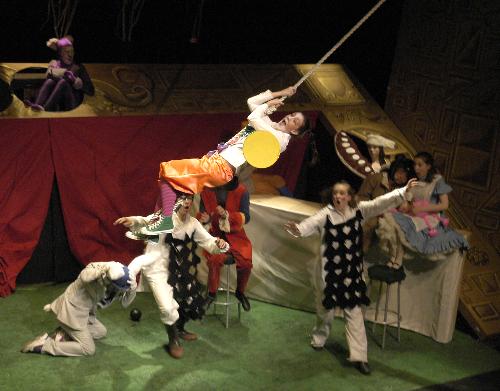
News
Garber Announces Advisory Committee for Harvard Law School Dean Search

News
First Harvard Prize Book in Kosovo Established by Harvard Alumni

News
Ryan Murdock ’25 Remembered as Dedicated Advocate and Caring Friend

News
Harvard Faculty Appeal Temporary Suspensions From Widener Library

News
Man Who Managed Clients for High-End Cambridge Brothel Network Pleads Guilty
Setting Marvels in Ex’s ‘Wonderland’
Innovative set design by Melissa E. Goldman ’06 transforms the Ex

When we return to the stories with which we fell in love as children, there is a temptation to read more into them than there may actually be, to search for multiple levels of interpretation that account for our continued fascination.
That is not a road taken by “Alice in Wonderland,” which will run through May 13 in the Loeb Ex. Here is a production of Lewis Carroll’s story that retains the original’s most memorable features while imbuing them with creative freshness rather than over-analysis. The result is an extremely ambitious production that succeeds in transforming a beloved book into a radiant theatrical spectacle.
The play combines material from both of Carroll’s Alice books: “Alice’s Adventures in Wonderland” and “Through the Looking Glass.” Director and Executive Producer John T. Drake ’06 has chosen an adaptation that does not collapse the two into a single narrative, as Carroll’s own stage version and the Disney movie do. Eva Le Gallienne and Florida Friebus’ script devotes a single act to each.
The first few scenes of the play are performed in front of a closed curtain by paper figures in a small toy theater as the endearingly cheeky Cheshire Cat (Rowan W. Dorin ’07) narrates. The live performance begins when the paper Alice tumbles down the rabbit hole in the toy stage, and the actual Alice (Sara L. Bartel ’06) stumbles out of the bottom of the figure stand.
Bartel gives an admirable performance in the title role. She emphasizes Alice’s wide-eyed wonder and befuddled consternation, but rarely veers into overstatement despite the outrageousness of the characters surrounding her.
And indeed, there is not a weak member in this ensemble. Each actor—even the silent ones—brings enormous energy to the role. Especially strong scenes are the tea party—where the Mad Hatter, March Hare, and Doormouse (Jess R. Burkle ’06, Jen H. Rugani ’07, and Masha O. Godina ’08) deliver their lines with flawless timing—and the exchanges between Alice and the Red and White Queens, played to perfection by Mary E. Birnbaum ’07 and Laurel T. Holland ’06.
The performances are appropriately complemented by a quirky choice of score, vibrant hair and makeup, and fantastic costuming designed by Casey M. Lurtz ’07. For example, Tweedle Dum and Tweedle Dee (Rugani and Jennifer L. Brown ’07) tell Alice the story of the Walrus and the Carpenter using illustrations on their skirts.
Acting and costuming thus combine for a re-imagining of each character that is extraordinarily successful. It does, however, fall short in a few instances—the most glaring of which is Drake’s decision to sexualize the Queen of Hearts (Lauren L. Jackson ’07). While this has the potential to be an interesting departure from the traditional chubby ball-buster, it is not executed well (no pun intended), and ultimately comes off as not within the spirit of the book, and more than a bit odd.
The most unique aspect of the production is its staging, where a fascination with the spaces formed in theater is manifest. This is primarily the achievement of Production and Set Designer Melissa E. Goldman ’06. The set is partially witty tribute to her thesis on toy theater.
The play begins with an actual stage frame in front—quite a feat for the Ex—appropriately adorned with enough spades, rabbits, and cats to resemble a set of Carrollian hieroglyphics. There are also a number of doors in it, which over the course of the evening exhibit their full potential as part of the visually stunning set. Challenges like how to portray characters growing, shrinking, disappearing, and transforming into pigs are solved with an inventiveness apropos of Alice’s uncanny bewilderment at what is transpiring.
This is a play clearly in love with the language of the books from which it is derived. The script keeps much of the poetry recited by various characters, and preserves a good number of the puns—at one point, a professorial mouse (Benjamin K. Glaser ’09) reads the tale of his life off of his tail.
But the adaptation does struggle to create a sense of continuity between two books with very different tones—the first is jubilantly frenzied, the second whimsically melancholy—which are themselves episodic tableaus rather that unified narratives.
Drake has elected to uphold this disparity between the two acts, which leads to an abrupt transition which lacks some resolution. Ultimately, however, it enriches the production, because the loyalty to Carroll’s original intent makes for a stronger base from which to venture into creative elaboration. The play’s final two scenes manage to conclude both the acts that preceded them and return us from our foray into Wonderland.
—Reviewer Jayme J. Herschkopf can be reached at herschk@fas.harvard.edu.
Want to keep up with breaking news? Subscribe to our email newsletter.
